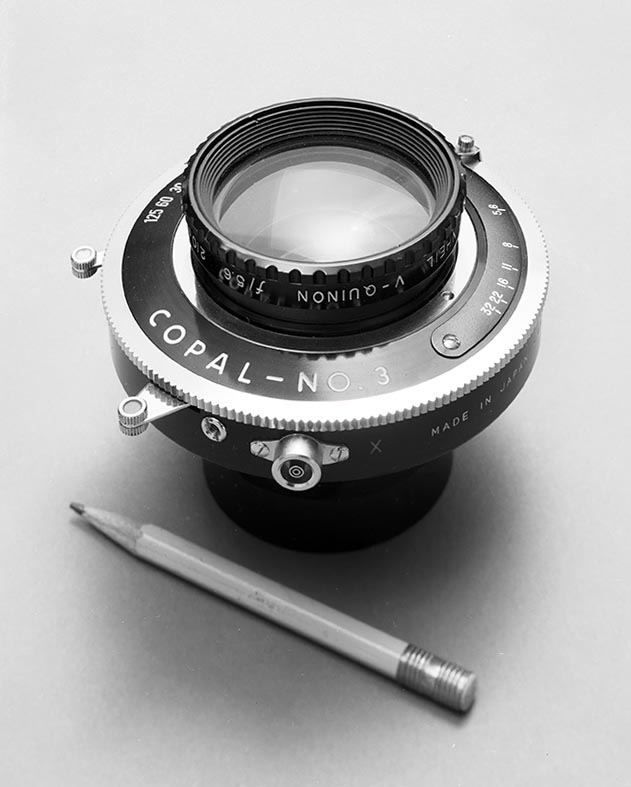
The Porta Vu 45 View Camera

In the early 80s, I mail-ordered a view camera kit called a Porta Vu 45 from Calumet in Chicago. Designed by Lester Fader, the kit was comprised of pieces of cherry wood rough-cut to dimension with slots, rabbets, and other features already milled into them. The kit included various hardware items like knobs, nylon washers, a hinge, leather strap, and fasteners. The end-user had to glue parts together, assemble, and finish the camera. No lens was included, and the price was very reasonable. I'm guessing $150 in early 1980s dollars.
Today CNC methods could produce the kit parts quickly and efficiently, but remember that this kit was produced well before CNC was available. I'm sure the parts were made by hand using jigs and other woodshop methods. It must have been labor intensive.
My particular kit was a folder. It had a hinged bed so that the camera could fold up to be more compact while carrying. A company called Bender also sold view camera kits but they were a monorail design.
For a better feel in use, I rounded over the sharp corners and edges of the wooden pieces with sandpaper. That also provided an improved appearance. After gluing and partial assembly, the wooden parts were finished with a MinWax oil finish.
I sold this camera and lens after about a year to buy a monorail Graphic View II view camera and a Schneider 210mm f/5.6 Symmar-S lens. The Porta Vu and Steinheil lens went to a buyer who worked at Battelle Memorial Institute in Columbus, Ohio. I cannot remember his name.
The Lens
I purchased a second-hand Steinheil V-Quinon 210mm f/5.6 lens in a Copal
shutter to use with it. It was sharp. Optically it is a planar design compared
to the more common plasmats like a Schneider 210mm Symmar-S. I wish that I still
had it to compare performance in different situations, i.e. wide aperture vs.
stopped down, close-up vs. distant, to detect subtle differences.

Usage
This camera had some weaknesses in its operation.
The chief culprit was the lack of locking strength of some of the movements. The rear tilt, in particular, frequently rotated by accident when inserting a film holder, or sometimes when focusing or attempting to significantly raise or lower the front standard. The locking mechanism for rear tilt was a knob threaded onto a small hanger bolt. The bolt was threaded into the wood using the half with wood threads, and the other half had machine screw threads for the knob.
Once I tried to strongly tighten the knobs to prevent unwanted tilt of the rear standard, and the hanger bolt started to pull out of the wood. To fix that, I cross-drilled the wooden piece through the hanger bolt and inserted a metal spiral pin at right angles. In the photo above, the small holes for the spiral pins can be seen on the rear standard's bottom cross-member, facing forward. This tweak helped, but didn't completely solve the problem. The design needed a larger contact surface between the parts that rotated (rear standard uprights and lower rear cross member) to provide more torque resistance without having to tighten the lock knob so severely.
Focusing was done by sliding the front standard forward and backward. There was no gear or friction drive. It did have a lock to secure focus once set. While sliding, there was a bit of slop that permitted small unwanted swings. This was mostly, but not completely, removed when the focus lock was tightened.
The folding feature didn't save a lot of space. It wasn't a clam-shell box like many commercial field cameras, and the glass was still exposed when folder. To collapse the camera, the front standard slid to the rear, and the hinged front half of the focus bed swung up against it. I believe that there was an elastic strap that held it there in the folded position, but I'm a bit hazy on that recollection.
Despite these weaknesses, the camera performed well enough to whet my appetite for additional view camera work. Its design flaws made me pay attention to any unwanted shift or tilt while photographing, and provided insight into which mechanical designs would perform better on future camera purchases. I have never spotted another Porta Vu or Steinheil lens since the time that I had mine in the early 1980s.
When I sold the camera, I had the distinct impression that the buyer wanted it to be a display piece or mantelpiece for his home. It was pretty to look at.
----------
Addendum: I found the original assembly instructions and converted them to a PDF for download.
William Schneider
© 2020